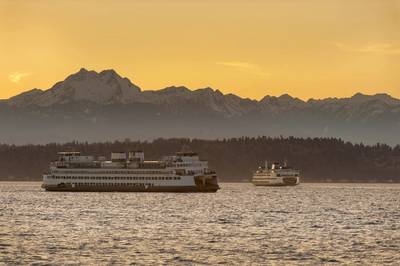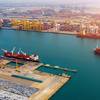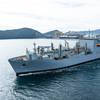Ferries V2.0. Post COVID Opportunities
Since the 1980s there has been a remarkable revival of ferry services in many U.S. waterfront cities, but COVID-19 has wreaked havoc on the most profitable component of these services: the commuter runs. With post-COVID work-at-home arrangements and part-week in-office work, these ferry services have suffered a tremendous loss of income. But there are glimmers of hope that a recovery is likely, although in a different form, in a different world.
Commuter runs are often the bread and butter portion of a ferry services, but only in the rarest cases can a profitable ferry service be created that only runs during commuter hours. The creation of such services often resulted in a strange design conundrum. Commuters might be attracted to a cleaner, or quicker, or more enjoyable commuter experience, but would often be hesitant to commit to a ferry commute if the ferry only ran during commuter hours. Many commuters have irregular hours, and, if the ferry only runs during peak hours, a commuter may not want to deal with the uncertainty of getting stuck in the city if they could not make it to the ferry by the last afternoon run.
Emerging ferry services often found that they could only capture commuters with rigid working hours and then hit a growth limit. This limit could be broken if the ferry services increased off hour runs, but since these runs would never run at full capacity, they operated at a loss, which then required an additional large investment, beyond the initial commuter service investment.
However, if the ferry service had sufficient financial legs, it could experience a second growth spurt where commuters with irregular hours will start to use the service. In addition, over time, city shoppers will start to take midday runs, and then business people will take the ferry for lunch or other meetings, and then, on nice days, tourists and sightseers will simply take a ferry ride for the fun of it. Then the ferry company can make an additional investment into smaller day time ferries and larger rush hour ferries (hi-lo mix optimization), and start to make serious money. This is a very complex issue with subtle variations depending on the ferry service’s location.
The consequence is that a ferry service takes years to establish, and, therefore, it may take years for it to turn a profit. The flip side to that issue is that once firmly established and properly fine-tuned, ferry services can be quite profitable.
So here came COVID, and in many service areas the ferries tied up due to total loss of ridership. But with odd exceptions. One ferry service managed to make a little money by securing a contract to carry healthcare workers to suitable transit points during the worst of the pandemic. And when ferries were allowed to run at reduced capacity, another ferry operator decided to take their larger ferries and run them at much reduced capacity for whale watching cruises, which could still turn a profit at reduced capacity (and at the same time provided a very nice customer experience with lots of space on a big, fast stable boat that was much better than whale watching on a crowded, slower and rockier smaller boat). Other ferry services started to organize reduced capacity excursions for customers desperate to get out of the house.
Then post peak COVID, ferry companies attempted to revive their commuter services, mostly at government mandated reduced capacity (and much reduced profit potential). Especially in summer, ferries were an attractive commuter option since they provided more personal distancing space, and fresh air on open decks compared to buses or trains.
However, this started the ferry conundrum all over again, and this time in an even more confusing form since rigid nine-to-five style commuters that could afford ferry commuting now had become much rarer. Many of those who were rigid nine-to-five commuters now stopped commuting entirely, or only commuted a few days per week. At reduced capacity it may be possible to fill a rush hour ferry, but what about the full day service runs, which were needed to provide a viable and profitable ferry service?
Right now, most ferry operators are functioning in this strange trial and error grey zone. The most frustrating part of this trial and error grey zone is that one cannot one day decide to start full day service and expect to know in one week, one month, or possibly even one year whether a full day service run is viable or not. This is due to the massive customer acceptance lag time in ferries. Ferry customers do not show up overnight; they need to be carefully cultivated, and this takes a lot of time
This lag time is further affected by the uncertainties that customers themselves face. Many pre-COVID commuters simply do not know what their commute will look like. They may be facing very unpredictable personal choices, and what were once vibrant commuter communities may no longer be commuter communities, or may actually become more heavily populated by part time commuters, or off hour commuters. However, while it is a complex issue for ferry operators, when considered at a larger transportation system level, it is nowhere near the devastation that bus and train operators are facing.
When compared to trains and buses, ferry operators have a number of advantages that may actually result in further use of ferries as compared to trains and buses and also personal transportation.
Consider the customer. The commuter customer used to choose its best option between bus, train or ferry. As long as they all provide all day service, the choice came down to time, quality and cost.
The time variable has not changed much, but the quality factor has, since ferries are inherently more outdoor oriented than trains and buses and also tend to be less crowded. As such, a commuter may now be more likely to choose a ferry over a bus or train for COVID risk reduction reasons.
With regard to cost, there is little difference pre or post COVID for a five-day commuter, but for a part time commuter, the reduced overall cost of the two or three day per week commute may very well compel her to opt for the ferry instead of the bus or the train. In other words, in part-time commutes, ferries may very well end up gaining, while the big losers will be buses and trains.
At this stage, it is difficult to predict what the long-term post COVID trends will be. An extreme result may be the total disappearance of traditional commuting. Potentially businesses may choose to shut down their center city operations, and commuters as we know them may completely disappear.
Strangely, even then, ferries may still be the winners. Ex-commuters may migrate to relatively isolated places without existing public transportation infrastructure, or may choose to live in places where public transportation infrastructure can be added at low cost. And the lowest initial investment public transportation infrastructure is ……. ferries.
Time for Ferries V2.0. May the smartest operators win.
For each column I write, Maritime Reporter & Engineering News has agreed to make a small donation to an organization of my choice. For this column, I nominate the Worldwide Ferry Safety Association (https://www.ferrysafety.org/), and in particular its student design competition, which has provided students with challenging design assignments for eight years now (https://www.ferrysafetydesigncompetition.org/).










